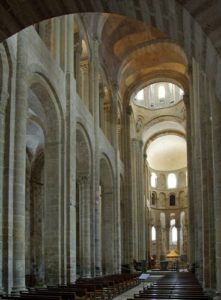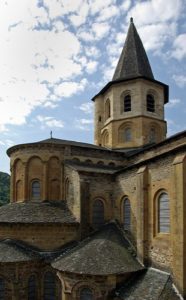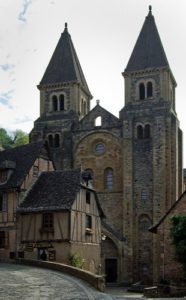The Abbey Church of St Foy is a magnificent Romanesque building with the only surviving medieval shrine on the pilgrim route to Santiago de Compostela.
A Benedictine Abbey was founded here in 819AD by a hermit called Dadon, as the pilgrim route to Santiago de Compostela passed close by. In 866AD a monk was dispatched to the monastery of Agen to steal relics of St Foy, a virgin martyred in 303AD under Diocletian and known for her ability to cure blindness and free captives. Once at Conques, these were placed in a golden statue. The monastery prospered and pilgrims left jewels to be added to the statue. In the 11thC the Abbey church needed to be replaced by a larger building which was finished in 1120.
The Chapter was dissolved after the Revolution, the church sold and most of cloisters disappeared to be used as building stone. The building was restored in the 19thC as it was about to collapse. It is now the parish church, but still attracts pilgrims.
There are two square tower at the east end with tall pointed roofs and a taller octagonal tower above the transept with a witch’s hat roof. The chancel apse has round pillars with round topped arches on the outside. Round it is the ambulatory with a lower roof line and apses off this with even lower roofs. The rest of the exterior is fairly plain with narrow buttresses. There are massive sandstone blocks at the corners with an infill of smaller granite or schist stones.
Entry is through the west door. Two wooden doors are set in a round topped arch with an amazing tympanum of the Last Judgement (1107-1125) above with at least 124 figures, including bishops, abbots and kings. There are still traces of the original paint.
Christ in Majesty presides over the scene in the centre, raising his right hand to show the way to the chosen and indicating the path of the damned with his left. Archangel Michael and a demon weigh the souls of the dead on scales at his feet. A procession of saints and historical figures move in procession on the left. On the right is a group of four angels and beside them are examples of punishments of the damned. Above Christ's head, angels hold banners with inscriptions.
On the bottom level, Heaven and Hell are depicted as roofed buildings, each with an entrance door. On the right side of the scene, the damned are forcibly pushed into the Jaws of Hell. On the left, the righteous are being welcomed by angels, who lead them gently by the hand to an ornate door. On the other side of the door, Heaven is shown as a city. In the centre is Abraham, who is embracing two saved souls. He is flanked by prophets on the right and saints on the left, each represented by pairs of men and women.
Once through the door, the overall impression is size. It is a plain building with a very tall nave which does make it feel narrow. Massive multi-sided pillars support round arches which give access to the side aisles. Above is a second level of smaller round arches which have a central pillar with carved capitals. The side aisles have supporting round topped arches along them and a barrel ceiling. Round topped windows in the side aisles and nave have plain glass. The chancel is small in comparison with a large ambulatory round it.
At the back of the nave steps give access to the west end towers and the galleries. There is a large organ above the west door. On the back wall is a gilt statue of the Virgin Mary with Christ. Opposite is the font with a carving of John the Baptist baptising Christ. There is a small carving on the north wall of the Annunciation with Gabriel and Mary.
The octagonal transept tower feels light and airy with eight round topped windows separated by round pillars. The tops meet at a central carved and pointed boss with a shield and bishop’s mitre.
The carved tops of the transept arches still have traces of red and blue paint. At the corners of the transept arches are carved figures including angels holding a book. Below is a simple mass altar and old wooden choir stalls with carved misericords.
The Sacristy in the south transept has the remains of 15thC frescoes on the walls in shades of blacks and blues. These show the martyrdom of St Foy, but it is difficult to make out details.
At the end of the south transept is an altar with a magnificent retable dedicated to St Foy. At the centre is a gold figure of St Foy holding a palm in her left hand and the sword that killed her in her right hand. She is surrounded by pale green pillars with gilt carvings of vine leaves and grapes. On either side are carved gilded panels showing the burning and beheading of St Foy. At the bottom of the retable is a decorative base with carved gilt panels and cherub heads. Above are cherubim with Christ holding an Orb.
To the right of this is another chapel with a simple old stone slab altar with a wooden carving of a pilgrim with a stick.
The chancel is surrounded by tall round pillars with round topped arches with the ambulatory behind. There are two more levels of round arches above. The stone high altar has carvings of a bishop on either side of St Foy. The figures are set in round topped recesses with gold decoration and separated by two round pillars with carved gold capitals. The stepped retable has more gold decoration and an integral host box with a gold door and cherub heads carved above it. To one side is an old wooden abbot’s chair.
The side aisles were used to channel pilgrims to the ambulatory where sacred relics displayed, so ensuring the monks were not disturbed at prayer. It is separated from the choir by a decorative iron grille with sharp spikes on top which was designed to protect the reliquaries from theft. These are now in the Treasury. Stone benches round the walls allowed the pilgrims to sit and rest. Three apses radiate off the ambulatory. The south one has a stone slab altar with a statue of the Virgin Mary. Above is large oil painting of the Virgin in Heaven surrounded by cherubim, looking down and blessing the people on earth. The centre apse has stone slab altar with a small crucifix. The north apse has a stone slab altar with a gilt statue of Joseph with the young Jesus. Above is a painting of Mary and Joseph with Elizabeth holding the baby John the Baptist.
The north transept has simple modern stone altar table with a host box covered with a cloth. To the left is an old stone altar. On the walls are a gilt and red statue of a bishop and a gilt and silver statue of St Francis de Sales 1567-1623.
The TREASURY is reached off the cloisters and is the most amazing collection of silver and gold plate reliquaries from the 9th-16thC. The highlight is the 9thC statue of Ste Foy en Majesté, which contains her relics. It is the only surviving example of the statue-reliquary shrine which was common in the Middle Ages and is the oldest surviving statue in western Christianity. Made from wood, it is completely covered in gold, precious and semi precious stones.
There is a more detailed review here.










